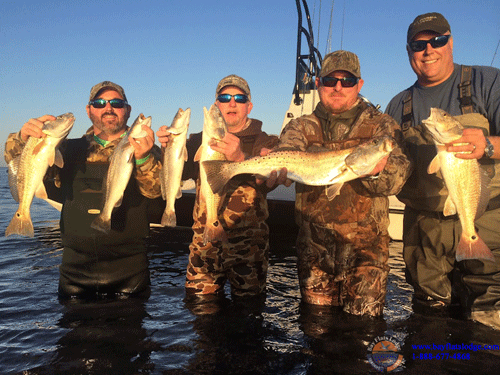
TTF flats minnows proved to be best during an afternoon casting & blasting session with Captain’s Harold and Ben Boudreaux. The Todd Carothers party enjoyed success with trout in the 25” class and a mix of reds while wade fishing over soft mud and grass on the windward shoreline of a back lake. The lures were rigged with 1/8 oz. heads while bouncing the TTF lures across the bay floor.
Bay Flats Lodge
Even though our portion of this winter’s arctic blasts appear to be minor in comparison to the rest of the nation, things have still managed to get quite cold around here on occasion. The amount of cold that we’ve seen along the coastline of Texas has proven to be very advantageous for this season’s duck hunters, but a lot of coastal anglers may not have experienced the same level of cold weather success that the hunters have had. Why? One reason is simple, and that is that a lot of anglers probably opt for staying at home by the fireplace when the air and the water turn really cold this month and next. But, naturally, that’s not the only reason. A lot of coastal anglers are not able to fish much except on weekends, and that in itself can often turn out to be quite a gamble more times than not. You can plan a “perfect” trip until you get tired of planning, but the odds are against you in having everything turn out in your favor when you actually get out on the water, especially during the winter months. You can, however, plan for contingencies in the event you are out on your winter weekend fishing trip and are faced with certain situations.
If you happen to be fishing just prior to the arrival of the next big frontal passage, there is more than a good chance that you may have to deal with a somewhat aggressive wind blowing out of the south. This is when you’ll need to be extremely careful when crossing large, open bays in order to position yourself within the confines of a protected shoreline. Those of us here along the mid-coast region of Texas would commonly recognize just such places as being locations like Matagorda Island and San Jose Island, where mile upon seemingly endless mile of barrier island shoreline separates the local inland bay systems from the vastness of the Gulf of Mexico. Over the years, these shorelines have given up innumerable prize trout and redfish catches, all the while offering coastal anglers the comfort and the protection they need when the south wind is pumping. But what do you do when the wind stops blowing out of the south, and the north wind starts tearing the flags off of the flag poles?
You probably won’t find anyone (in their right mind, that is) who will recommend you attempt to ride out the onset of a “true-blue norther” as it rips across one of our big bays. Doing so can be very dangerous, if not downright deadly. If you wake up on the Saturday morning of your weekend trip and notice a strong cold front blowing through, it’s probably better not to get out on the water. Wait and see how things look early on Sunday morning. The north wind may calm down enough by then to allow you to be able to take advantage of some places containing deeper water and that can often offer some protection from a cold north wind. Such locations in our neck of the woods would include places like the stretch of the ICW (Intracoastal Waterway) between San Antonio Bay and West Matagorda Bay, the Victoria Barge Canal which starts near the town of Seadrift, the Colorado River that empties near the town of Matagorda, and occasionally the Army Hole which is situated out on Matagorda Island across Espiritu Santo Bay from the town of Port O’Connor. Anglers will notice that the bay floor contour in these places will generally have a somewhat steep drop-off in spots. Tossing a favorite bottom-hugging plastic bait directly up against the bank and then dragging it ever so slowly across that drop-off has proven to be quite effective on the fish more times than anyone can begin to imagine.
Of course, if you’re down for the weekend and everything happens to go “as planned”, meaning that you’ve managed to be on the water between fronts when there’s not much wind to speak of, the sun hen your options (all of a sudden) tend to multiply exponentially, even if you haven’t been fishing in several months. The shell pads out in San Antonio Bay could experience some of the hottest trout action at any moment, and some of the slightly deeper drains and ditches connecting the back lakes out on Matagorda Island could begin to come alive with the very next falling tide. And that’s just for starters, because when you have bays the size of San Antonio Bay, Espiritu Santo Bay, and West Matagorda Bay the possibilities become seemingly endless.
Remember to practice CPR, “Catch, Photo, and Release”, whenever possible on trophy Trout and Reds…Guide Chris Martin, Port O’Connor/Seadrift region. www.BayFlatsLodge.com …1-888-677-4868
